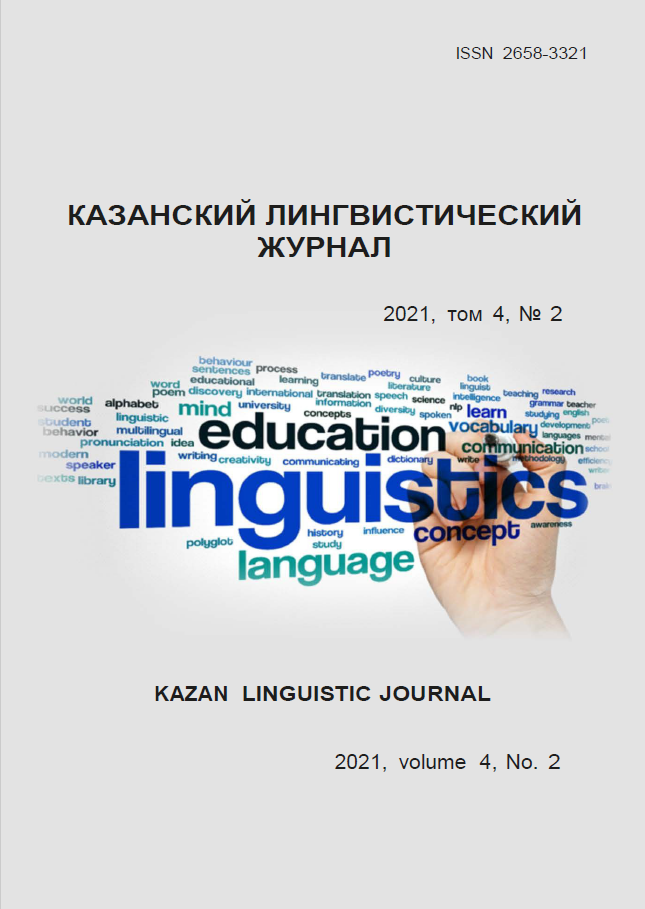Didactic aspects of translatological trilinguism
Keywords:
trilingualism, educational process, language as a cultural mediator, Russian language, languages of the peoples of Russia, literary and oral translation, three-vector methodological complexAbstract
In the era of extremely rapid intellectual and social transformations the role of translatological trilingualism is expanding in both cross-cultural interaction and teaching languages and translation studies. To date, researchers have assigned to trilingualism the status of a special form of multilingualism, which reflects the mechanism of the formation of a linguistic and social personality, which has unlimited pedagogical, psychological and didactic potential. The article reveals the available studies on trilingialism both in Russia and abroad, as well as the potential for their implementation in the educational process. In addition to conventional trilingualism that covers the anthropological, sociolinguistic and sociocultural components, there is another field where trilingualism is characterized by presence of the same text in three languages – that is the field of literary translation that deals with transferring a work of fiction from one language into another language through an intermediary one. Thus, the role of the Russian language as a cultural mediator assisting in translation of the world literature into the languages of the peoples of Russia is increasing. The authors assume application of the trilingual model to expand the functions of AI. The Master’s programme on “Theory of Translation Studies, Cross-cultural and Cross-lingual Communication”, implemented at Kazan Federal University, as well as the extra-curriculum educational courses and programmes being taught in Saint-Petersburg and Almaty, adduce evidence of both their efficiency and problems associated with introduction of three-vector methodological complexes.
References
Список литературы
Алоси-Фонт Э., Товар-Гарсиа Э. Д. Трилингвизм, билингвизм и образовательные достижения на примере чувашского и татарского языков в сельском регионе России. Вопросы образования. 2018. № 3. С. 8–35.
Бузаджи Д.М., Гусев В.В., Ланчиков В.К., Псурцев Д.В. Новый взгляд на классификацию переводческих ошибок. М.: Всероссийский центр переводов научно-технической литературы и документации, 2009. 120 с.
Дилдабекова А.К. Русский как язык-посредник в процессе перевода с казахского на другие языки. Вестник Российского университета дружбы народов. 2017. T.8, № 4. С.1228–1236.
Кабакчи В.В. Англоязычное описание русской культуры. М.: Издательский центр «Академия», 2009. 224 с.
Комиссаров В.Н. Современное переводоведение: учеб. пособие. M.: ЭТС, 2002. 424 с.
Лихачева А.Н. Трилингвизм как языковой феномен и методический прием формирования учебно-познавательной деятельности учащихся при обучении второму иностранному языку: психолого-педагогический аспект. Мир науки. Педагогика и психология, 2020. No2. // URL: https://mir-nauki.com/PDF/80PDMN220.pdf (доступ свободный). Загл. с экрана. Яз. рус., англ.
Сабирова Д.Р., Кондратьева И.Г. Обучение иностранным языкам в условиях билингвизма и многоязычия. Сборник научных трудов «Иностранные языки в современном мире». Казань, 2020.
Фомин М.М. Обучение иностранному языку в условиях многоязычия (двуязычия). М.: Мир книги. 1998. 213 с.
Фомиченко Л.Г. Билингвизм и трилингвизм сходства и различия. Вестник Волгоградского государственного университета. Серия 2: Языкознание. 2005. С. 96–100.
Шевнин А.Б. Переводческая эрратология: новый взгляд на описание концептуальной и языковой картины мира. Теория и практика перевода и профессиональной подготовки переводчиков: устный перевод. 2008. С.209–214.
Academic.ru // URL: https://dic.academic.ru/dic.nsf/bse/155443/%D0%AF%D0%B7%D1%8B%D0%BA
Arnaus-Gil L., Müller N., Sette N. & Hüppop M. Active bi- and trilingualism and its influencing factors. International Multilingual Research Journal. Volume 15, 2021. Issue 1. // URL: https://www.tandfonline.com/doi/abs/10.1080/19313152.2020.1753964?journalCode=hmrj20
Engel Ch., Birgit Menzel B. (Hrg.) Kultur und / als Übersetzung. Berlin: Frank&Timme, 2011. 344 s.
Hoffmann Ch., Ytsma J. Trilingualism in Family, School and Community. Multilingual Matters. 2003. DOI: https://doi.org/10.21832/9781853596940
Poeste M., Müller N., Arnaus-Gil L. Code-mixing and language dominance: bilingual, trilingual and multilingual children compared // International Journal of Multilingualism Volume 16, 2019. Issue 4. // URL: https://www.tandfonline.com/doi/full/10.1080/14790718.2019.1569017
References
Alòs i Font H., Tovar-García E.D. (2018). Trilingualism, Bilingualism and Educational Achievements: The Case of Chuvash and Tatar in Rural Russia. Voprosy obrazovaniya. № 3. P. 8–35. (In Russian)
Buzadzhi D.M., Gusev V.V., Lanchikov V.K., Psurtsev D.V. (2009). Novyi vzglyad na klassifikatsiyu perevodcheskikh oshibok. M.: Vserossiĭskii tsentr perevodov nauchno-tekhnicheskoi literatury i dokumentatsii. 120 p. (In Russian)
Dildabekova A.K. (2017). Russian as the interim language in the process of transfer Kazakh to other languages. RUDN Journal of Language Studies, Semiotics and Semantics, 8(4), 1228–1236. (In Russian)
Kabakchi V.V. (2009). Russian Culture Through English. М.: Izdatel'skii tsentr «Akademiya». 224 p. (In Russian)
Komissarov V.N. (2002). Modern translation studies. Moscow, ETS Publ. 424 p. (In Russian)
Likhacheva A.N. (2020). Trilingualism as a linguistic phenomenon and methodical reception of students' educational and cognitive activity formation in teaching the second foreign language: psychological and pedagogical aspect. World of Science. Pedagogy and psychology, [online] 2(8). // URL: https://mir-nauki.com/PDF/80PDMN220.pdf. (In Russian)
Sabirova D.R., Kondrateva I.G. (2020). Foreign language education bilingualism and multilingualism. Collection of scientific works “Foreign languages in the world”. Kazan. (In Russian)
Fomin M.M. (1998). Obuchenie inostrannomu yazyku v usloviyakh mnogoyazychiya (dvuyazychiya). M.: Mir knigi. 213 p. (In Russian)
Fomichenko L.G. (2005). Bilingvizm i trilingvizm skhodstva i razlichiya. Vestnik Volgogradskogo gosudarstvennogo universiteta. Seriya 2: Yazykoznanie. P. 96–100. (In Russian)
Shevnin A.B. (2008). Perevodcheskaya erratologiya: novyĭ vzglyad na opisanie kontseptual'noi i yazykovoi kartiny mira. Teoriya i praktika perevoda i professional'noi podgotovki perevodchikov: ustnyi perevod. P.209–214. (In Russian)
Academic.ru // URL: https://dic.academic.ru/dic.nsf/bse/155443/%D0%AF%D0%B7%D1%8B%D0%BA
Arnaus-Gil L., Müller N., Sette N. & Hüppop M. (2021). Active bi- and trilingualism and its influencing factors. International Multilingual Research Journal. Volume 15. Issue 1. // URL: https://www.tandfonline.com/doi/abs/10.1080/19313152.2020.1753964?journalCode=hmrj20 (In English)
Engel Ch., Birgit Menzel B. (Hrg.) (2011). Kultur und / als Übersetzung. Berlin: Frank&Timme. 344 s. (In German)
Hoffmann Ch., Ytsma J. (2003). Trilingualism in Family, School and Community. Multilingual Matters. DOI: https://doi.org/10.21832/9781853596940 (In English)
Poeste M., Müller N., Arnaus-Gil L. (2019). Code-mixing and language dominance: bilingual, trilingual and multilingual children compared // International Journal of Multilingualism Volume 16. Issue 4. // URL: https://www.tandfonline.com/doi/full/10.1080/14790718.2019.1569017. (In English)






